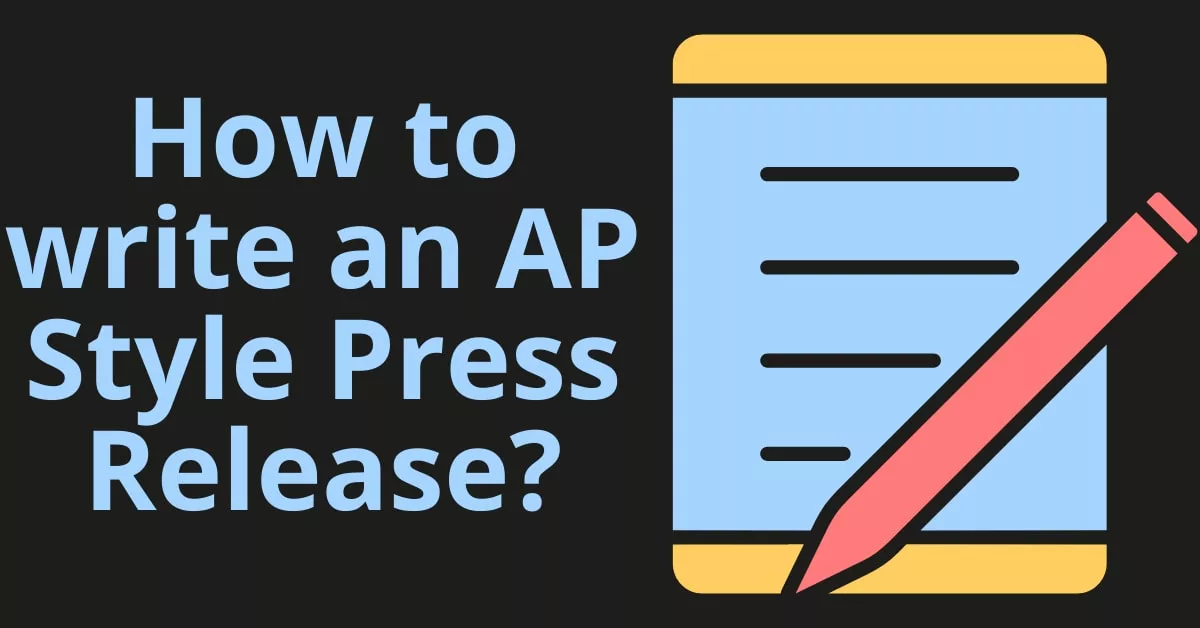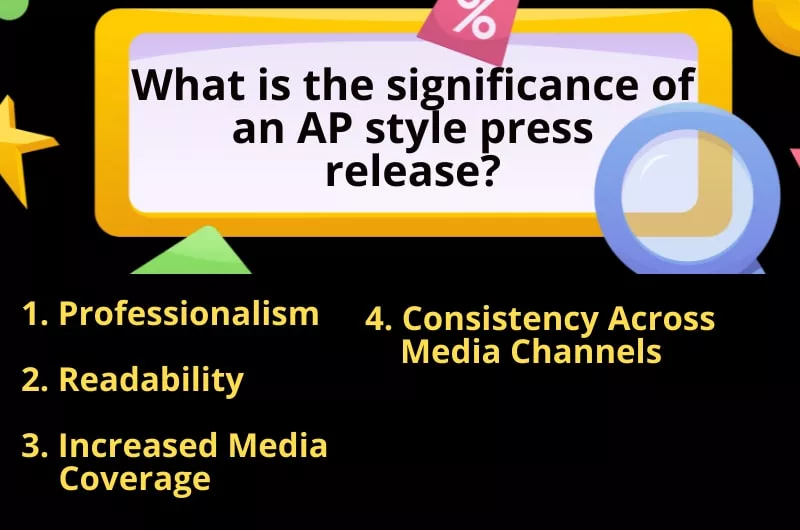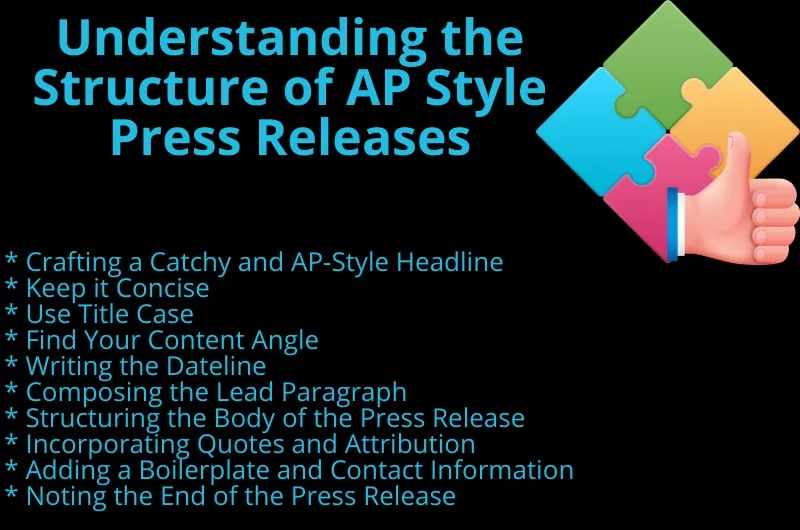How to Write an AP Style Press Release?

by Avneet Singh
If you’re looking to make your news story stand out in the competitive world of journalism, mastering the Associated Press (AP) Style is an essential skill. An AP Style press release is not just a document, it’s a strategic communication tool that ensures your message reaches journalists and readers with clarity, consistency, and professionalism.
Founded in 1846, The Associated Press (AP) is a globally recognized and influential news agency based in the United States. It has a rich history and plays a pivotal role in providing news and information to the media around the world. The Associated Press has established its own style guide, known as the AP Stylebook, which serves as a standard for journalistic writing and formatting. It covers rules for grammar, punctuation, capitalization, and more, and it is widely used by journalists, writers, and editors.
In this blog post, we’ll walk you through the key elements of writing an AP Style press release, offering valuable tips and insights that will help you effectively convey your message to the media and your target audience.
What is the Significance of an AP Style Press Release?
Here are some key reasons why you should consider writing an AP Style press release:
Professionalism
AP Style is the industry standard for journalistic writing and formatting. When you write a press release in AP Style, it immediately signals to journalists and media professionals that you understand and adhere to the highest standards of journalism. This professionalism enhances the credibility of your news.
Readability
AP Style provides guidelines for clear and consistent writing. This ensures that your press release is easy to read and understand, reducing the chances of misinterpretation or errors that could arise from inconsistent language or formatting.
Increased Media Coverage
Journalists and media outlets are more likely to pick up and use press releases that are written in AP Style because it makes their job easier. When your press release follows AP Style, it aligns with the norms and expectations of newsrooms, increasing the likelihood of media coverage.
Consistency Across Media Channels
AP Style is not limited to written content but extends to multimedia formats as well. When your press release is in AP Style, it can seamlessly integrate with other forms of media, such as news articles, broadcasts, and online content, ensuring a consistent message across different platforms.
Understanding the Structure of AP Style Press Releases
AP Style is the industry standard for writing and formatting news stories, and mastering the structure of an AP Style press release can significantly increase your chances of getting your story picked up and published. In this section, we will break down the key components of a press release format in AP Style, step by step.
Crafting a Catchy and AP-Style Headline
The headline is the first thing journalists and readers see, making it the most critical element of your press release. It should be concise, engaging, and written in AP Style. Here’s how to create a headline that grabs attention while following AP Style:
Keep it Concise: AP Style recommends headlines to be no longer than 80 characters, including spaces.
Use title case: Capitalize the major words in your headline, excluding articles, prepositions, and conjunctions. Avoid promotional language: Focus on the news angle rather than making it sound like an advertisement.
Find Your Content Angle
Before you start writing, identify the unique angle or story within your press release. What makes your news newsworthy? This could be a product launch, a significant achievement, a timely event, or a newsworthy development within your organization. our content angle should be clear and compelling, providing a hook that draws readers in.
Writing the Dateline
The dateline, placed at the beginning of your press release, includes the release date and the location where the news originated. It should follow this format: CITY, State (or Country) – Date. For example, “New York, NY – September 27, 2023.” The dateline is essential for indicating when and where the news is happening or originating.
Composing the Lead Paragraph
The lead paragraph, also known as the lead, is arguably the most critical part of your press release. It should answer the who, what, when, where, why, and how of your news within the first one or two sentences. Journalists often make quick decisions about whether to pursue a story based on the strength of the lead paragraph, so make it concise and attention-grabbing. Consider it your “elevator pitch” to the media.
Structuring the Body of the Press Release
The body of your press release provides additional details, context, and supporting information for your news. To structure it effectively:
Use short paragraphs: Short paragraphs make your press release more digestible and reader-friendly.
Utilize bullet points: Break up dense text with bullet points to highlight key facts or statistics.
Place the most important information first: Follow the inverted pyramid structure, with the most crucial information at the beginning, followed by supporting details.
Incorporating Quotes and Attribution
Quotes from key figures in your organization or subject matter experts can add credibility and a human element to your press release. When incorporating quotes, Always state the speaker’s full name and title, followed by the quote. For example: “John Smith, CEO of XYZ Corp, said, ‘This is a significant milestone.'”
Adding a Boilerplate and Contact Information
A boilerplate is a brief description of your organization, its mission, and its contact information. It’s typically placed at the end of the press release and provides background information about your company. Also, include clear contact information for media inquiries, including a name, phone number, and email address.
Noting the End of the Press Release
To signal the conclusion of your press release, use the traditional “###” or “—END—.” This notifies readers and journalists that there are no more pages or additional content to follow.
Things to Know About AP Style Formatting Guidelines
In addition to the content structure, adhering to established press release guidelines is necessary. The Associated Press (AP) Style is one such set of guidelines that has become the industry standard for clear, consistent, and concise writing. Let’s learn about press release format AP style guidelines.
Spacing
Single Spaces: AP press release format recommends using a single space after periods, colons, and semicolons. This practice differs from the older convention of using two spaces after a period.
Em Dash Spacing: Use one space before and after em dashes (—) when used within a sentence. This helps maintain consistency in your text.
Numbers
Spell Out Low Numbers: Spell out numbers from one to nine; use numerals for 10 and above. For example, “five employees attended, but 12 were expected.”
Numerals for Percentages: Always use numerals for percentages, such as “5% increase in sales.”
Dates
Month-Day-Year Format: In AP press release format, use the month-day-year format with commas when including a specific date. For example, “The event will take place on September 27, 2023.”
Month and Day (No Year): When referring to a day within the current or next seven days without mentioning the year, use just the month and day. For instance, “The conference is scheduled for October 15.”
Commas
Serial Comma: AP Style advocates for the use of the serial comma (also known as the Oxford comma) in a series. This means placing a comma before the final “and” or “or” in a list. For example, “The colors of the flag are red, white, and blue.”
Perspective
Third-Person Writing: Write in the third person when creating content in AP Style. Avoid using the first-person pronouns “I” and “we” in news articles or press releases.
Fonts & Font Sizes
Standard, Readable Fonts: Use standard and easily readable fonts for your documents, such as Times New Roman, Arial, or Calibri. Avoid decorative or unusual fonts that may hinder readability.
12-Point Font Size: Maintain a 12-point font size for the main body of your text. Headings and sub-headings may be slightly larger for emphasis and clarity.
Headings & Sub-headings
Use title case for headings and sub-headings within your document. Capitalize the major words in the heading, excluding articles, prepositions, and conjunctions.
AP Style Press Release Examples & Templates
The following AP Style press release example will provide a clear understanding of all the aspects covered in this guide.
Company Milestone Press Release
If you need more ap-style press release templates, check out this blogpost.
In conclusion, mastering the art of writing an AP Style press release is a valuable skill that can open doors to effective communication and media coverage. By adhering to the guidelines we’ve explored in this blog post, you can ensure that your press releases are not only well-structured but also aligned with the standards of professionalism and clarity demanded by journalists and media outlets.
Recommended Posts

10 Common Press Release Mistakes & How To Fix Them?
March 8, 2024

How To Write Great PR Pitches? [With Examples]
February 24, 2024

How to Write Great Press Release Headlines?
February 15, 2024




